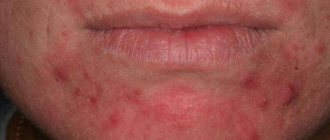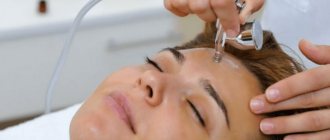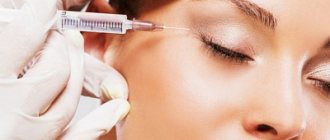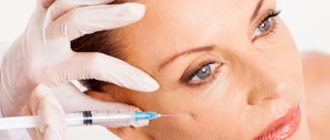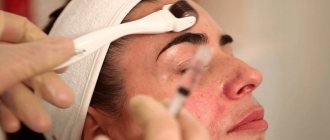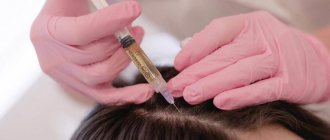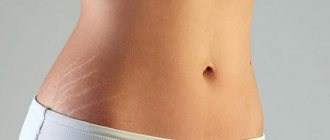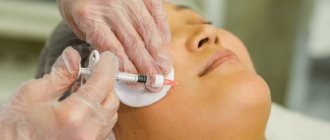From this article you will learn:
- The essence of hardware facial mesotherapy
- Types of hardware facial mesotherapy
- Stages of hardware mesotherapy for the face
- Advantages and disadvantages of hardware facial mesotherapy
- Preparations for hardware mesotherapy of the face
- Indications and contraindications for hardware mesotherapy of the face
- 5 best devices for facial mesotherapy
- Cost of hardware facial mesotherapy
Hardware facial mesotherapy is a popular procedure among modern fashionistas. It is the face that is the calling card of every person, especially a girl. Flawless skin evokes the envy of women and the interested glances of men. Ungroomed and sagging skin can add ten extra years to even a young lady. This cannot be allowed!
To make every meeting delight people, you need to constantly take care of your face. How to do this with the help of mesotherapy, what cocktails and devices are used in modern clinics, we will tell you in our article.
The essence of hardware facial mesotherapy
With the help of mesotherapy, metabolic processes in the epidermis are improved and restored. Skin cells are exposed to negative external influences as a result of insufficient vitamin content. Hardware facial mesotherapy is a cosmetic procedure that, in one session, can replenish the lack of nutrients, as well as correct noticeable imperfections.
Women in Europe learned about this effective technique 20 years ago, while in Russia they began to use it only recently. At first, this rejuvenating technique of administering vitamins was not well received by our compatriots, as it had some unpleasant aspects: it was necessary to pierce the skin, and this led to bleeding and lengthy rehabilitation. In addition, the procedures turned out to be painful for most women, so mesotherapy was resorted to only in extreme cases.
Over time, the beauty service has undergone many improvements, as a result of which it has become painless and bloodless - thanks to the use of special technical means that do not damage the skin.
The principle of hardware mesotherapy is also based on the introduction of vitamin complexes into the skin, but using sonophoresis, and not the head, as in the case of conventional mesotherapy. Ultrasound is often effectively used to improve the passage of substances. For hardware mesotherapy, as well as for standard manipulations, specialists use a mesoinjector with a special head with spikes attached to its tip. To simplify and speed up the procedure, the devices are equipped with a manual and automatic mechanism. The exact dosage, depth and speed of drug administration is determined by a special program built into the equipment.
Using the traditional method of injecting drugs, it is possible to treat significantly smaller areas of the skin than using hardware mesotherapy.
Devices for manipulations
Despite the fact that quite a lot of devices for carrying out the procedure are produced, only 2 devices are used in cosmetology practice, the efficiency of which is higher than when using similar devices:
| Name | Description |
| Meta-DUO | The device allows you to produce a direct electric current of a pulsed nature, the frequency of which is 3.3 kHz. It is used not only for electroporation, but also for radiofrequency lifting. |
| Meta-TDS | The device makes it possible to produce pulses whose frequencies do not exceed 2 kHz. This feature allows you to use the device to quickly rejuvenate the skin, eliminate stretch marks or scar surfaces. |
The devices described above belong to the premium segment, which is why their price is quite high. Their presence in the beauty salon characterizes the clinic as high-quality and professional.
For home use, you can purchase simpler and more compact devices, of which the most popular is the line of devices from the Russian manufacturer Gezaton.
Meta-TDS device for electroporation of lips with hyaluronic acid
The price of home appliances ranges from 1,500 rubles. up to 7,000 rubles, depending on the type of use, internal characteristics and advanced functionality. Many of them are used for the purpose of electrical stimulation of natural skin processes at the cellular level, as well as its treatment in case of age-related changes.
Home use of the device is strictly carried out only after an initial consultation with specialists in the field of dermatology and cosmetology, who will help you choose the right type of device, determine the exact schedule of sessions or complete a training course.
Types of hardware facial mesotherapy
Non-invasive mesotherapy used in modern cosmetology comes in several types, each of which has its own characteristics. When choosing a technology, the individual needs of the patient and his age are taken into account. It is important to determine the client’s skin condition and the expected effect of the procedure.
Types of hardware mesotherapy:
- Electroporation. It is a variant of electrophoresis. The method is based on the impact on skin tissue of high-frequency pulses that can penetrate into the deep layers of the skin and open aquaporin channels. Thus, all useful substances are delivered to maximum depth.
- Cryomesotherapy. A method that allows you to achieve a good long-term anti-aging effect. During the procedure, the skin is exposed to cold and electricity. Thanks to the laser, active substances are introduced into the deep layers of the skin and remain there for a long time, providing a lifting effect.
- Oxygen therapy (OX Y). A procedure based on the impact on skin tissue of dense air jets containing molecules of anti-aging drugs. Nutrient air currents activate beneficial substances that penetrate into the deep layers of the epidermis. This method is intended to improve facial skin health, improve and even out its color.
- Magnetophoresis . A technique that allows for deep absorption of all beneficial substances due to the effect on the skin using magnetic waves.
- Ultraphonophoresis. A method based on ultrasound exposure of the skin. Thanks to this technique, blood vessels are strengthened, cell metabolic processes are activated, and blood circulation is improved.
Important! There are special devices for sale for carrying out mesotherapy at home. It is not recommended to purchase them, since you will not be able to perform this procedure on your own, without sufficient skills and experience: it should be done by professionals.
The energy of physical factors has long been successfully used in various areas of medical practice. A special place among them is occupied by physiotherapy - the use of physical factors for therapeutic, preventive and rehabilitation purposes. Modern medicine actively uses them in a number of new methods and technologies that are borderline for classical physiotherapy. These methods primarily include:
a) shock wave therapy is a method of extracorporeal exposure of body tissues to acoustic impulses of significant amplitude or shock waves [1, 2];
b) photodynamic therapy is a method that includes two components, one of which is a photosensitizer that accumulates in the tissue, and the other is powerful laser (light) radiation of a certain wavelength [3, 4];
c) methods based on the use of the energy of physical factors (ultrasound, magnetic field, light, etc.) to create pores in the cell membrane, ensuring an increase in its permeability for various substances [5-7].
The main distinctive feature of the presented methods is the use of physical factors of much greater power than in physiotherapy.
In recent years, electroporation therapy has been very actively being developed, which can be considered a special type of medicinal electrophoresis. This method is less known to physiotherapists and balneologists, which was the motivation for preparing this review article.
Theoretical foundations and biophysical mechanisms of the method
Electroporation is the formation of pores in biological objects (cell membranes, skin, etc.) under the influence of a high-intensity short-pulse electric field. At first it was only about cell membranes, but today the method has been extended to many tissues, primarily the skin. Changes in the properties of a cell membrane under the influence of an electric field are due to the peculiarities of the behavior of its lipid bilayer [8, 9]. In this case, the following sequence of events under the influence of a pulsed electric field is assumed: primary conformational changes in bilayer lipids (violation of dipole orientation), an increase in existing and the emergence of new hydrophobic pores, and the development of the latter into more stable secondary hydrophilic pores [10]. The sizes of hydrophilic pores change over time depending on the strength and duration of the electrical influence, which determines the further fate of the membrane and the cell as a whole: either “tightening” of the pores and restoration of the original (low) permeability of the cell membrane, or irreversible changes up to cell death.
For pores to form, it is necessary that the parameters of the electric field used exceed threshold values, which vary widely among different cells. Generally, the threshold for cell membrane destabilization increases as cell radius decreases. Therefore, electroporation of bacterial cells requires a higher electric field strength than is necessary to increase the permeability of mammalian cells [5]. Depending on the type of cell and the size of the molecules that need to be delivered into the cell, the field strength range can vary from 100 V/cm to several thousand, and the pulse duration varies from 100 μs to 10 ms. For the delivery of drugs into the cells of humans and all mammals, fields with a strength of 1000 V/cm and a pulse duration of 100 μs are quite effective, while fields of lower strength but longer pulses are required for gene transport [11].
The relationship between these dosimetric parameters of the electric field and the effects they cause is schematically presented in Fig. 1 [11].
Rice. 1. Dependence of electroporation effects on electric field parameters.
When studying the effect of an electric field, for example, on the membranes of erythrocytes, it was found that all impulses cause their electroporation, the threshold of which does not depend on the form of the stimuli supplied. When two pulses are applied, non-additive rates of decrease in the number of erythrocytes as a result of electroporation are observed: two different-polar stimuli caused a greater effect compared to two unipolar ones [12]. Various authors have shown that the electroporation process, in addition to the dosimetric parameters of the electric field, is influenced by such factors as the size and shape of cells, the thickness and conductivity of the membrane, as well as mechanical stress on it [13, 14].
During electroporation, the primary biophysical process is the induction of a transmembrane potential by pulses of an external electric field, followed by membrane breakdown and the formation of lipid pores [15]. According to V.F. Antonov, from the point of view of permeability, lipid pores are fundamentally different from protein channels in their origin and exceptional dynamics. While protein channels have strictly defined sizes that remain throughout the life of the cell, the size of lipid pores during the flow process varies widely [16]. However, this variability has limitations. If the pore radius is less than the critical one, then during the flowing process it must pass through all intermediate sizes and reach the minimum. It is assumed that the complete tightening of lipid pores is prevented by powerful hydration forces that manifest themselves when the walls of hydrophilic pores approach each other [17].
Lipid pores, unlike protein ion channels, do not have pronounced selectivity, which correlates with their relatively large initial sizes (radius up to 4 nm). Lipid pores can be used by the cell to transport high-molecular substances, ions and water molecules.
Unlike solid dielectrics, pores in the membranes of living tissues can quickly (after about 30 s) disappear after the termination of the pulsed electric field without residual changes in the initial permeability of cells (reversible electroporation). With reversible electroporation, cells are able to undergo a process of increasing permeability, which can be used to deliver various chemical and biological ingredients into the cell. Through the holes formed during electroporation, molecules of various chemical compounds, drugs and biologically active substances, which are normally unable or weakly pass through the surface membrane of the cell, can freely penetrate. The effect of reversible electroporation is used in biotechnological research, gene therapy and active electropharmacotherapy.
When exposed to defective cells and using powerful pulses of an electric field, irreversible electroporation occurs, characterized by the appearance of large pores and an increase in the permeability of cell membranes, leading to cell death. Irreversible electroporation is increasingly used in oncology for the treatment of certain forms of malignancies.
The exact mechanism of electroporation is still unknown, although this phenomenon is already used in biotechnology and medicine. As already noted, it is assumed that in a bilayer lipid membrane, under the influence of high-intensity electrical pulses, a local reversible restructuring of its structure occurs, leading to the appearance of a through water channel. There are two main pore configurations possible: hydrophilic and hydrophobic. In hydrophilic pores, the walls are formed by phospholipid “heads”, and in hydrophobic ones - by lipid “tails”. At small radii, hydrophobic pores are energetically favorable, and at large radii, hydrophilic pores are energetically favorable. Depending on the parameters of the electrical pulse, the dynamics of the formed pores may be different. It is important that pores in the membranes of living tissue can disappear relatively quickly after the cessation of the action of the physical factor. At the same time, the time of existence of the pores, as studies have shown, is sufficient for increased penetration of necessary drugs or therapeutic biological substances into the cell.
Studies performed on the stratum corneum of human skin, which is the main barrier to the transport of substances, have shown that high-voltage electrical pulses cause electroporation in it. Moreover, depending on the parameters of exposure and the condition of the skin, electroporation of the stratum corneum can also be reversible or irreversible [18].
In general, the principle of electroporation is illustrated in Fig. 2.
Rice. 2. Scheme of the principle of electroporation.
Electroporation equipment
In many countries, electroporation devices are produced for various purposes. The largest group consists of devices intended for use in cosmetology and dermatology. Information about the most important of them is given in the table.
Devices for electroporation in cosmetology Note. fе is the frequency of electrical impulses; I - current strength; fu—ultrasound frequency; fm—modulation frequency; U is voltage; W—power; tu is the pulse duration.
Many of the devices intended for use in cosmetology are combines that, along with electroporation, provide ultraphonophoresis, massage, cryotherapy, oxygen therapy, peeling, etc. These devices include: BHS 030, BHS 010 (Argentina), EPUS (South Korea), NV-CR 200B (China), Body Beauty Clinic Ultrasound (Italy), Mesoderma (Italy), Derma S (South Korea), ES-9090 (China), RF Zone (Spain), etc. Most often used for electroporation in cosmetology three types of devices: MesoDerma, Infusion and META-TDS.
There are a number of devices for electroporation that are used in biotechnology and oncology: NanoKnife system and Genetronics (USA), Cliniporator (1-5000 Hz, 100-1000 V, 100 μs, Italy), etc. The devices offer a wide variety of electrode configurations that widely used in medical research [11].
A number of experimental samples of devices have been described that allow electroporation in various fields of biology and medicine [13, 18-20]. The installation for the combined procedure of electroporation and sonoporation deserves special mention [10]. To increase the efficiency of cell permeability and increase their viability, the authors proposed a device that provides a controlled combined effect of pulsed electric fields (tension from 1 to 7 kV/cm) and acoustic waves (amplitude up to 100 MPa). The operating principle of electroporators known today is based on the accumulation of charge on a capacitor with its subsequent discharge through a biological load (cell, organ or tissue).
Electroporation therapy
Electroporation has been used for quite a long time in various biotechnological processes (methods): initiation of cell fusion and sorting, delivery of expressing gene constructs, biological pacemakers, vaccines, etc. [5, 7, 11, 19, 21-24].
In recent years, it has found application in various fields of medicine, primarily in oncology, dermatology and cosmetology. The use of electroporation for therapeutic and prophylactic purposes is called electroporation therapy.
Electroporation therapy can be performed ex
vivo
and
in vivo
.
ex vivo
therapy, autogenous or heterogeneous cells suspended in aqueous solutions are mixed with the drug. This suspension is placed between electrodes and then exposed to short, high-voltage electrical pulses. Cells “loaded” with a large amount of drug are either further processed before being administered to the patient, or can be directly administered to the patient.
In pharmacotherapy, the use of erythrocytes as carriers of medicinal substances is considered promising. This method of therapy can be used to correct enzymopathies, remove toxic compounds from the blood, and in chemotherapy for cancer [25]. Among the methods of incorporating substances into red blood cells, electroporation has become widespread. The electroporation procedure boils down to the following: a suspension of erythrocytes is prepared from the original donor blood, which is then incubated in a medium including isotonic solutions of sodium chloride and sucrose, then it is mixed with a hematocrit of 10-20% with the drug that needs to be “sealed” into the cell, and exposed to a single electrical pulse at 25 °C, after cooling the suspension to 4 °C and incubation, spontaneous closure of the pores is carried out in an osmotically balanced environment at 37 °C. As a result of this treatment, erythrocytes become practically indistinguishable from control ones both in shape and volume, as well as in transmembrane transport activity and viability [26].
A study of the pharmacokinetics of erythrocytes loaded with protein and anthracycline drugs showed that their lifespan after injection into the bloodstream is 3-4 weeks. This is a period that is tens of times longer than the duration of circulation of drugs in the bloodstream if they are administered directly into it. In addition, the use of “loaded” red blood cells dramatically reduces the side effects of drugs.
in
vivo
therapy, a therapeutic agent is administered systemically or locally, and then the area of the pathological lesion (for example, a tumor) is subjected to electroporation, which must be synchronized with the heart rhythm to avoid the development of arrhythmia. The presence of arrhythmia and an artificial pacemaker in the patient is a contraindication to electroporation. Studies show that electroporation of a tumor can increase the intracellular concentration of the drug to a level that is many times higher than that usually observed with traditional pharmacotherapy [6, 7, 11]. Therefore, high intracellular concentrations can be achieved in electroporated tumor cells with relatively low extracellular accumulation of the drug. Since electroporation expands the pores and increases the permeability of the cell for a short time, the drug that has penetrated into it becomes trapped, due to the fact that the permeability is quickly restored (becomes low), thus significantly increasing the intracellular residence of the drug substance, lengthening its pharmacotherapeutic effect . Ultimately, this leads to the creation of high pharmacotherapeutic activity of the drug in the absence of systemic toxic and adverse reactions. This approach is most actively tested in relation to the treatment of malignant neoplasms both experimentally and in the clinic.
The first report foreshadowing the potential widespread therapeutic use of electroporation was published by M. Okino and H. Mohri [27]. In it, the authors reported on the treatment of tumor-bearing mice with injections of bleomycin; a significant slowdown in the growth of the tumor was observed only when it was subjected to electroporation after administration of the chemotherapy drug. Since then, various countries have begun to try to use electroporation therapy in the treatment of malignant tumors in animals and humans, using various combinations of chemotherapeutic agents and variations in electroporation. Let us present for illustration at least some experimental and clinical data.
In experiments on mice with transplanted pancreatic adenocarcinoma, the effectiveness of treatment with bleomycin alone (control) and its combination with electroporation (1300 V/cm, 6 pulses of 99 μs each with an interval of 1 s) was compared. 28 days after electrochemotherapy, almost complete tumor regression was observed in 90% of mice. 77 days after the start of treatment, complete regression without palpation of the tumor was observed in 66% of cases. 20% of mice experienced secondary tumor growth 35 days after treatment, but at a much slower rate compared to controls.
The authors repeated the experiment with neocarcinostatin, which also demonstrated the high effectiveness of electrochemotherapy in mice with large cell lung tumors. It has been shown that treatment using electroporation after injection of the drug is more effective than the administration of neocarcinostatin after electroporation [28].
I.V. Mizgirev et al. studied the effect of electrochemotherapy (a combination of bleomycin and electroporation) on the growth of B16 melanoma and Ehrlich carcinoma in mice. Electroporation was carried out at an electric field strength of 1000-1200 V/cm and a pulse duration of 100 μs. The study found that electrochemotherapy stopped tumor growth regardless of the dose of bleomycin. Electroporation with bleomycin had a more significant effect on the growth of Ehrlich carcinoma. At a high dose of bleomycin (1000 mg), the method caused complete remission in 7 out of 10 mice with melanoma, and only 3 animals relapsed 129 days after electrochemotherapy [29].
The successful treatment of B16/F10 melanoma in mice by electroporation of the gene encoding interleukin-12 has been described. Intratumoral (electric field strength 1500 V/cm, pulse duration 100 μs) and intramuscular (electric field strength 100 V/cm, pulse duration 20 ms) administration of the recombinant protein was compared. With intratumoral electrochemotherapy, cure was observed in 47% of mice, and 70% of cured animals became resistant to melanoma cells. There was no tumor regression with intramuscular electrochemotherapy [30].
The effectiveness of electroporation with bleomycin was demonstrated in a study conducted in cats with periocular carcinoma and advanced squamous cell carcinoma. The effect after electroporation therapy was noted in 89% of cases (21 animals had an irreversible reaction, 2 had a partial reaction), while in the control (treatment with bleomycin only) - only in 33% of cats. The average progression time in the electrochemotherapy group was 30.5 months, and in the control group - 3.9 months ( p
<0,0001) [31].
Electroporation is also quite actively used in clinical settings, mainly for superficial tumors and metastases.
D.N. Panchenkov et al. used irreversible electroporation (non-thermal ablation) of colorectal cancer liver metastases. Based on the analysis of data from ultrasound, clinical laboratory and pathohistological studies, the high efficiency of the method was proven, as well as its safety for the vascular and ductal structures of the liver [32]. Other authors have also shown in experiments on pigs and rats that irreversible electroporation causes tissue ablation without damaging the walls of large vessels and the endothelium [33, 34].
Japanese authors used irreversible electroporation for ablation in patients with hepatocellular carcinoma with a mean diameter of 17.5 ± 6.3 mm. In 83% of patients, the tumor was successfully cured without recurrence (follow-up period 244±55 days). When using electroporation, patients experienced only mild complications [35]. R. Cheng et al. observed in 5 out of 6 patients with hepatocellular carcinoma after electroporation, complete tumor necrosis without any signs of its viability. And only 1 patient had less than 5% of viable tumor cells in the periphery [36]. The results of the use of irreversible electroporation (Nanoknife device) in patients with hepatocellular carcinoma indicated not only the effectiveness of the method, but also its comparability with data from the use of radiofrequency ablation [37]. Irreversible electroporation was used to treat 65 perivascular malignant liver tumors in 38 patients. 6 months after ablation, residual changes in the tumor were observed in 1 case and local relapses in 3 cases [34]. There are other reports of the successful use of electroporation and electrochemotherapy for liver tumors [38-40].
Irreversible electroporation and electrochemotherapy are also used for other locations of malignant tumors. U. Reinhold studied the use of electroporation with applications of small doses of chemotherapy for skin and subcutaneous tumors and metastases. Based on the data obtained, the author considers the method simple, safe, effective and quite affordable [41].
S. Tafuto et al. analyzed information about the clinical effectiveness of electrochemotherapy using electroporation (Cliniporator device) for pancreatic cancer and liver metastases [42]. They came to the conclusion that this method is highly effective, simple and accessible for this pathology. Other authors also point to the effectiveness of electroporation therapy for pancreatic cancer, including its unresectable forms [43-45].
There is positive experience in the use of various electroporation technologies for renal cell carcinoma [46], prostate cancer [47, 48], skin melanoma and its metastases [49, 50], and brain tumors [51, 52].
Electroporation and electrochemotherapy with bleomycin or cisplatin first cause short-term vasoconstriction, and then disruption of the cytoskeletal structure and suppression of the barrier function of the capillary endothelium. The antivascular effect of electrochemotherapy is used in the treatment of melanoma metastases: an irreversible reaction was observed in 70-80% of cases [53].
The electroporation method was experimentally successfully used to treat pulmonary emphysema in mice. The keratinocyte growth factor gene ( KGF)
).
Intramuscular electroporation of the KGF
was accompanied by stimulation of proliferation of the pulmonary epithelium and protection of depression of lung function in mice with simulated emphysema [54]. The method of electroporation therapy in experimental and clinical medicine is also used in other areas [51, 55-58].
Electroporation is used even more actively for transdermal transfer of drugs in dermatology and cosmetology.
At the Center for Medical Cosmetology of the Federal State Budgetary Educational Institution of Higher Professional Education "North-Western State Medical University named after. I.I. Mechnikov" of the Ministry of Health of Russia studied the effectiveness of external treatment of androgenetic alopecia with zinc hyaluronate using the electroporation method. Studies have shown that when zinc hyaluronate is introduced by electroporation into the scalp with androgenetic alopecia, hair density increases, the ratio changes significantly towards the predominance of anagen hair, and the diameter and number of terminal and thick hair increases [59].
In cosmetology practice, the following method of electroporation therapy is most often used: using ultrasound or other manipulations, the skin is cleansed of dead cells and its permeability increases, then the handpiece of the electroporation device is filled with a solution of the medicinal substance and the electroporation procedure (needle-free mesotherapy) is carried out. Duration of exposure is 20-25 minutes, 8-10 procedures per course, 1-2 procedures per week. The most commonly used medicinal substances in cosmetology are hyaluronic acid and its salts, as well as anti-cellulite preparations.
Indications for the use of electroporation in cosmetology are the following diseases and conditions: wrinkles, decreased skin turgor, alopecia, scarring, acne, cellulite, skin condition after peelings, acne, etc.
Electroporation is contraindicated in cases of epilepsy, diabetes, pregnancy, presence of a pacemaker, atrial fibrillation, and open wounds.
Electroporation is the main component in a complex method called aquaphoresis and is used for non-invasive transdermal transfer of drugs in the correction of age-related skin changes, cellulite therapy and a number of diseases.
Aquaphoresis includes the following stages:
a) tissue stimulation with laser radiation in the red and infrared ranges;
b) electroporation;
c) electromyostimulation and interference therapy;
d) lymphatic drainage.
Aquaphoresis is used in dermatology, cosmetology and plastic surgery, neurology, traumatology, sports and rehabilitation medicine [60].
To improve the delivery of drugs (vasopressin, neurotensin, calcitonin) to the skin, electroporation is combined with electrophoresis or ultrasound [6, 61, 62].
Thus, a new electrotherapeutic method based on the use of a high-intensity pulsed electric field and called electroporation has been proposed and is being actively developed. Depending on the parameters of the physical factor, the method causes temporary or irreversible formation of pores and an increase in the permeability of the cell membrane, accompanied by various changes in the cell, up to its death. Electroporation is already being used in biotechnology and medicine. In accordance with the known mechanisms of action of electroporation and technical capabilities, the method is still most widely used in oncology, dermatology and cosmetology. Being essentially a representative of physical methods, electroporation should be more actively researched, developed and used by physical therapists for nervous, internal, skin and other diseases. Reviews of recent years [5, 24, 63-68] and the works analyzed in them, it seems, will convince the interested reader of the prospects for the development of electroporation therapy and its use in various fields of medicine.
There is no conflict of interest.
Stages of hardware mesotherapy for the face
There is a certain algorithm for performing non-injection mesotherapy. The difference in each case may be the method of hardware action and the ingredients of the nutritious meso-cocktail.
Procedure steps:
- First, dead cells are removed from the skin. To do this, cleanse with enzyme or acidic agents. Sometimes, to increase blood flow, a special cryomassage is performed.
- After the skin is completely prepared, a beneficial serum is applied. The meso cocktail is formulated taking into account the individual characteristics of the patient in order to avoid the occurrence of unwanted allergic reactions.
- According to the chosen technology, hardware treatment of problem areas is performed, the task of which is to deliver useful substances to the deep layers of the epidermis. The process lasts approximately 15–30 minutes. Sometimes the client feels a slight tingling sensation in the area of treatment.
- At the end of the hardware treatment, soothing agents (cream, mask or gel) are applied to the skin, designed to consolidate the effect obtained.
- After 30 days, a maintenance procedure must be performed.
Advantages and disadvantages of hardware facial mesotherapy
The method of hardware facial mesotherapy has a number of advantages compared to other procedures that have the same cosmetic effect:
- non-traumatic and painless - the patient feels practically nothing during the session;
- lack of a long rehabilitation period - complete recovery will take no more than 2 hours;
- uniform distribution of the drug;
- quick achievement of results;
- a variety of compositions of healthy meso-cocktails, thanks to which there is a choice (based on the individual characteristics of the skin);
- short duration of the procedure;
- no risk of infection;
- a wide variety of hardware options.
According to reviews from clients who are afraid of injections (suffer from trypanophobia), hardware facial mesotherapy is ideal for them.
The disadvantages of non-invasive mesotherapy include:
- The depth of drug administration is less than with the traditional invasive method, which significantly weakens the effect.
- Many procedures need to be done before the desired result is achieved and maintained for a long time.
- The procedure is quite expensive and requires constant consolidation sessions.
This method is very popular (despite all its shortcomings) due to the fact that the skin is not injured by needles during the procedure.
Recommended articles on the topic:
- Ultrasonic facial peeling is a pleasant and beneficial procedure for your skin
- Redermalization of the skin: all the pros and cons
- Almond peeling for the face: features of the procedure
A well-formulated meso-cocktail, strict adherence to the application technique and hardware influence can almost completely avoid negative consequences.
Very rarely, the following complications may occur after the procedure:
- Redness on the surface of the skin, which persists for several hours (in this case, it is necessary to apply a soothing and emollient agent).
- Various allergic reactions.
- Swelling as a result of exposure to laser, ultrasound or magnetic waves.
- Lymphostasis of post-traumatic type.
- Changes in the epidermal layer of a degenerative nature.
Complications appear in only 1–2% of all procedures performed. After mesotherapy, the patient is advised to strictly adhere to all skin care recommendations regarding the rehabilitation period.
Progress of the scalp electroporation procedure
Mesotherapy without injections for the purpose of treating and strengthening hair should only be carried out by a qualified specialist. The procedure algorithm is as follows:
- The surface of the skin where microcurrent exposure is planned is treated with a nutrient mixture. The composition is selected individually, based on the patient’s complaints, symptoms and desired results.
- Turn on and set up the device for electroporation.
- Perform the procedure.
Hardware action allows the components of the nutritional cocktail to reach the hair follicles. The bulbs penetrate:
- microelements, vitamins;
- growth stimulants;
- cell activators;
- substances for normalizing lymph and blood flow;
- moisturizing components, etc.
Before
After
Male, 30 years old, alopecia areata
- Course of 10 physiotherapy procedures
- Electroporation
- Bioptron
- Cryo massage
- Stimulant drug
Before
After
Woman 38 years old Diagnosis of alopecia areata
- Treatment external therapy
- Course of 15 physiotherapy procedures
- Electroporation
- Cryomassage
- Stimulant drug
Preparations for hardware mesotherapy of the face
The procedure for non-injection mesotherapy includes two mandatory elements: the introduction of a meso-cocktail and hardware treatment of problem areas, which increases the ability of epidermal tissue membranes to pass beneficial substances through themselves.
The set of mesococktail components is selected individually for each patient depending on the existing problems. These vitamin serums are designed to solve various cosmetic problems, therefore they are divided into several varieties.
Allopathic therapy
An allopathic mesococktail is not complete without:
- minerals;
- vitamin complex;
- glycolic, thioctic or pyruvic acids;
- natural extracts of beneficial plants;
- drugs such as dihydroergotamine or L-carnitine;
- drugs manufactured using biotechnology.
Before preparing an individual allopathic serum, testing is carried out for the occurrence of an allergic reaction to a particular component.
Homeopathic mesotherapy
Homeopathic meso-cocktail consists only of components of plant origin and composite substances that are found in the structure of many tissues and organs. A mixture for homeopathic mesotherapy cannot contain anything other than extracts of medicinal plants.
Ready-made preparations for mesotherapy
When preparing ready-made mixtures, all indications are taken into account. Cocktails often include:
- folic and hyaluronic acid;
- complexes of vitamins and minerals;
- coenzymes;
- preparations with zinc and magnesium gluconate;
- substances that have a bleaching effect.
Whatever the good composition, it has its own application characteristics, as well as individual indications and contraindications. Therefore, before starting a procedure using a meso-cocktail, you should definitely seek advice from a specialist.
Advantages and disadvantages
In terms of lasting effect, electroporation is inferior to injection and plastic methods of lip augmentation. Many cosmetologists recommend the procedure as the main method to moisturize the skin, restoring its elasticity and freshness.
Electroporation of the lips with hyaluronic acid (the price depends on the type of device and the cosmetology clinic) cannot overdo it in terms of lip augmentation, therefore for patients who do not want to increase the volume too much, this method of exposure is the best option.
Physiotherapeutic treatment of the skin using weak electrical impulses allows you to:
- Eliminate any painful sensations. In the case of electroporation, the patient may experience a slight tingling sensation without much discomfort. Only in some situations is it possible to develop allergic reactions and other unpleasant symptoms, but this feature is a physiological reaction of the body.
- Preserving the natural integrity of the skin. With the help of physiotherapeutic effects, it is possible to achieve normalization of regenerative processes in the skin, therefore the procedure is most often used for restorative or healing purposes.
- Availability. Unlike many other procedures, especially injections and plastic surgery, the cost of electroporation is quite low. In this case, several sessions are enough to achieve the effect.
- No recovery. In the case of a physiotherapeutic procedure, the patient can do without a recovery period, as indicated by a minor invasive intervention.
- Minimal number of contraindications. Electroporation avoids significant complications, which is possible due to the low number of various restrictions. However, other types of exposure with the same effectiveness cannot guarantee similar safety.
- Low chance of allergies. Since hyaluronic acid can be synthesized using the internal parts of the body, it is not a foreign element. Therefore, although cases of allergic reactions occur, such symptoms are quite rare in practice.
In addition to the advantages described above, electroporation makes it possible to attend several sessions at once until the desired effect is achieved. If the patient wants to receive a small volume and initial hydration of the lips, 1-2 visits will be enough.
The procedure has practically no objective disadvantages. The main thing is to choose an experienced specialist and clinic, which will allow you to avoid a number of complications that are typical for any type of invasive intervention. An ineptly performed technique can cause harm even with such an easy physiotherapeutic method of influence.
Although lip augmentation using electroporation is quite safe, there is still a risk of injury to the skin. If all precautions and rules are followed, the safety of physiotherapy increases to 100%.
Indications and contraindications for hardware mesotherapy of the face
The method of non-injection mesotherapy allows you to:
- improve the health of thin, irritated skin;
- moisturize dry skin;
- give your face a fresh, healthy color;
- eliminate fine wrinkles around the eyes;
- get rid of signs of photoaging;
- remove swelling, dark circles under the eyes;
- eliminate hyperpigmentation;
- cope with “stars” (rosacea) and vascular network;
- reduce pores;
- even out skin color in areas of scars, scars, post-acne;
- cure acne, pimples;
- normalize the function of the sebaceous glands, reduce fat content;
- eliminate the first signs of aging, prevent the formation of wrinkles;
- solve the problem of facial ptosis, jowls, fuzzy oval, double chin.
If a woman has undergone an aggressive cosmetic procedure (for example, laser or chemical peeling) or plastic surgery, experts advise mesotherapy. In addition, this anti-aging effect is recommended when preparing for any cosmetic procedures.
We recommend
Laser aesthetic cosmetology: a perfect technique for an ideal appearance More details
The use of the method is allowed for any skin type and at any age. However, there are some contraindications to hardware effects. It is not allowed to perform non-injection facial mesotherapy if:
- skin diseases (in the acute period) in problem areas;
- renal failure and cholelithiasis;
- blood diseases, symptoms of hemophilia;
- infections, inflammatory processes, herpes in the active phase;
- unhealed wounds, fresh scars;
- individual intolerance to any ingredients included in the drug;
- diabetes mellitus;
- pregnancy and lactation;
- the presence of neoplasms on the skin;
- strong traces of hyperpigmentation in the treated areas.
Before performing hardware facial mesotherapy, the cosmetologist must make sure that this event will not harm the patient seeking help. To do this, the specialist conducts a thorough examination and determines all possible contraindications. It happens that a cosmetologist does not recommend mesotherapy.
Contraindications
Despite the absolute safety of electroporation, it has contraindications that are important to observe in order to prevent consequences after its implementation.
The following health restrictions are prescribed:
- Pregnancy.
- Lactation.
- Tumors.
- Cardiovascular diseases.
- Diabetes.
- Low blood clotting rate.
- Dermatological damage.
- Fungal diseases.
- Herpes.
Cost of hardware facial mesotherapy
The price of hardware facial mesotherapy is influenced by various factors, such as:
- category of cosmetology clinic, professionalism and qualifications of employees;
- condition of the skin;
- dosage of administered drugs;
- components of a complex of vitamins and minerals;
- area of treated areas;
- type of technology used.
The capital's cosmetology clinics offer their services for non-injection facial mesotherapy in the price range of 2000–6000 rubles per session. If it is necessary to correct the décolleté area, the cost of one procedure will be from 4,000 rubles and more. In the regions, the average price for one session may be less – from 1,500 rubles.
Why clients choose Veronika Herba Beauty and Health Center:
- This is a beauty center where you can take care of yourself at a reasonable cost, while your face and/or body will be treated not by an ordinary cosmetologist, but by one of the best cosmetologists in Moscow. This is a completely different, higher level of service!
- You can receive qualified help at any time convenient for you. The beauty center is open from 9:00 to 21:00, seven days a week. The main thing is to agree with your doctor in advance on the date and time of your appointment.
Sign up for a consultation with a specialist by phone +7 (495) 085-15-13
, and you will see for yourself!
Non-injection mesotherapy on the body allows you to solve problems:
- Rejuvenation and lifting of the skin of the décolleté and neck area.
- Treatment of various types of cellulite and modeling of body contours.
- Reduction of stretch marks and stretch marks, postpartum strictures.
- Preparation and rehabilitation after surgical operations, microdermabrasion, laser skin resurfacing.
A course of body treatments consists of 12-15 procedures. The maintenance course is recommended to be carried out 1-2 times a month.
Advantages of non-injection mesotherapy (electroporation) using the InfusionTM device
- No needles, papules from injections or signs of inflammation.
- The absence of marks on the skin allows you to perform it at any time and immediately go to the ball.
- Painlessness of the technique.
- Possibility of introducing low- and large-molecular substances, including hyaluronic acid preparations.
- The concentration of the injected substance is more than 90%.
- Long-term retention of results (up to a year).
- No seasonal restrictions.
Sign up for cosmetology by phone
Services and prices
Needle-free mesotherapy using the Infusion device (Israel). Intensive facial hydration (1 ampoule)
3,700 rub.
Needle-free mesotherapy using the Infusion device (Israel). Collagen restoration (smoothing wrinkles, improving skin structure) (1 ampoule)
RUB 3,800
Needle-free mesotherapy using the Infusion device (Israel). Lifting-tightening and modeling of the oval face (1 ampoule)
RUB 3,900
Needle-free mesotherapy using the Infusion device (Israel). Intensive treatment of stretch marks (1 ampoule)
3,400 rub.
Needle-free mesotherapy using the Infusion device (Israel). Firm skin (1 ampoule)
3,700 rub.
Needle-free mesotherapy using the Infusion device (Israel). Treatment of cellulite (1 ampoule)
RUB 3,150
Sergeeva Anna Vyacheslavovna Head of office, dermatovenerologist Work experience: 17 years
